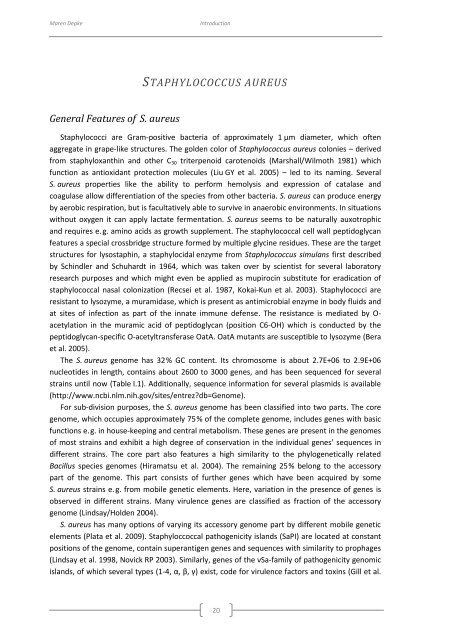genomewide characterization of host-pathogen interactions by ...
genomewide characterization of host-pathogen interactions by ...
genomewide characterization of host-pathogen interactions by ...
You also want an ePaper? Increase the reach of your titles
YUMPU automatically turns print PDFs into web optimized ePapers that Google loves.
Maren Depke<br />
Introduction<br />
STAPHYLOCOCCUS AUREUS<br />
General Features <strong>of</strong> S. aureus<br />
Staphylococci are Gram-positive bacteria <strong>of</strong> approximately 1 µm diameter, which <strong>of</strong>ten<br />
aggregate in grape-like structures. The golden color <strong>of</strong> Staphylococcus aureus colonies – derived<br />
from staphyloxanthin and other C 30 triterpenoid carotenoids (Marshall/Wilmoth 1981) which<br />
function as antioxidant protection molecules (Liu GY et al. 2005) – led to its naming. Several<br />
S. aureus properties like the ability to perform hemolysis and expression <strong>of</strong> catalase and<br />
coagulase allow differentiation <strong>of</strong> the species from other bacteria. S. aureus can produce energy<br />
<strong>by</strong> aerobic respiration, but is facultatively able to survive in anaerobic environments. In situations<br />
without oxygen it can apply lactate fermentation. S. aureus seems to be naturally auxotrophic<br />
and requires e. g. amino acids as growth supplement. The staphylococcal cell wall peptidoglycan<br />
features a special crossbridge structure formed <strong>by</strong> multiple glycine residues. These are the target<br />
structures for lysostaphin, a staphylocidal enzyme from Staphylococcus simulans first described<br />
<strong>by</strong> Schindler and Schuhardt in 1964, which was taken over <strong>by</strong> scientist for several laboratory<br />
research purposes and which might even be applied as mupirocin substitute for eradication <strong>of</strong><br />
staphylococcal nasal colonization (Recsei et al. 1987, Kokai-Kun et al. 2003). Staphylococci are<br />
resistant to lysozyme, a muramidase, which is present as antimicrobial enzyme in body fluids and<br />
at sites <strong>of</strong> infection as part <strong>of</strong> the innate immune defense. The resistance is mediated <strong>by</strong> O-<br />
acetylation in the muramic acid <strong>of</strong> peptidoglycan (position C6-OH) which is conducted <strong>by</strong> the<br />
peptidoglycan-specific O-acetyltransferase OatA. OatA mutants are susceptible to lysozyme (Bera<br />
et al. 2005).<br />
The S. aureus genome has 32 % GC content. Its chromosome is about 2.7E+06 to 2.9E+06<br />
nucleotides in length, contains about 2600 to 3000 genes, and has been sequenced for several<br />
strains until now (Table I.1). Additionally, sequence information for several plasmids is available<br />
(http://www.ncbi.nlm.nih.gov/sites/entrez?db=Genome).<br />
For sub-division purposes, the S. aureus genome has been classified into two parts. The core<br />
genome, which occupies approximately 75 % <strong>of</strong> the complete genome, includes genes with basic<br />
functions e. g. in house-keeping and central metabolism. These genes are present in the genomes<br />
<strong>of</strong> most strains and exhibit a high degree <strong>of</strong> conservation in the individual genes’ sequences in<br />
different strains. The core part also features a high similarity to the phylogenetically related<br />
Bacillus species genomes (Hiramatsu et al. 2004). The remaining 25 % belong to the accessory<br />
part <strong>of</strong> the genome. This part consists <strong>of</strong> further genes which have been acquired <strong>by</strong> some<br />
S. aureus strains e. g. from mobile genetic elements. Here, variation in the presence <strong>of</strong> genes is<br />
observed in different strains. Many virulence genes are classified as fraction <strong>of</strong> the accessory<br />
genome (Lindsay/Holden 2004).<br />
S. aureus has many options <strong>of</strong> varying its accessory genome part <strong>by</strong> different mobile genetic<br />
elements (Plata et al. 2009). Staphyloccoccal <strong>pathogen</strong>icity islands (SaPI) are located at constant<br />
positions <strong>of</strong> the genome, contain superantigen genes and sequences with similarity to prophages<br />
(Lindsay et al. 1998, Novick RP 2003). Similarly, genes <strong>of</strong> the νSa-family <strong>of</strong> <strong>pathogen</strong>icity genomic<br />
islands, <strong>of</strong> which several types (1-4, α, β, γ) exist, code for virulence factors and toxins (Gill et al.<br />
20

















